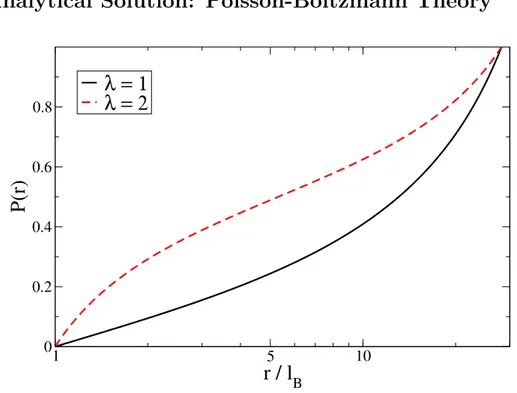Simulation Methods in Physics II SS 2019
Worksheet 5: Charge Distribution Around a Charged Rod
Kartik Jain, David Sean, Olaf Lenz and Mehmet Süzen Institute for Computational Physics, University of Stuttgart
Contents
1 Introduction 2
2 Short Questions - Short Answers 2
3 The Simulated System 2
4 Analytical Solution: Poisson-Boltzmann Theory 3
5 Computer simulations 4
5.1 Mapping the Cell Model onto a Simulation . . . . 4
5.2 Warmup Runs . . . . 5
5.3 Equilibration and Sampling Time . . . . 6
5.4 Measuring the Charge Distribution . . . . 7
Bibliography 8
General Remarks
• Deadline for the report is Wednesday, 3rd of July 2019, 12:00 noon
• In this worksheet, you can achieve a maximum of 20 points.
• The report should be written as though it would be read by a fellow student who attends the lecture, but doesn’t do the tutorials.
• To hand in your report, send it to your tutor via email.
– Kartik (kartik.jain@icp.uni-stuttgart.de)
• Please attach the report to the email. For the report itself, please use the PDF
format (we will not accept MS Word doc/docx files!). Include graphs and images
into the report.
• The report should be 5–10 pages long. We recommend using L A TEX. A good template for a report is available online.
• The worksheets are to be solved in groups of two or three people.
1 Introduction
This tutorial is based on an article by Deserno et al. 1 , and we will try to reproduce the plots in the article in this tutorial using computations. Deserno 2 is a more comprehensive reference for the tasks of this tutorial.
Task (2 points)
• Read the article by Deserno et al. 1 in detail.
You can access it online: http://pubs.acs.org/doi/abs/10.1021/ma990897o If you have trouble accessing the article, write an email to your tutor and he will answer soon!
2 Short Questions - Short Answers
Task (3 points)
Answer the following questions:
• Explain the concept of counterion condensation?
• What does the Bjerrum length describe?
• Describe the concept of a mean field theory.
3 The Simulated System
The system under consideration is a so-called cell model of a polyelectrolyte, i.e. a polymer that dissociates charges in solution (cf. lecture). In the cell model, a poly- electrolyte is modelled as a single, charged, infinite rod with its counterions and maybe some additional salt that is confined to a cylindrical cell. The observable of interest is the distribution of ions P(r) around the rod.
To tackle the problem of obtaining the charge distribution, we will introduce two meth- ods:
1. Poisson-Boltzmann theory, which is an analytical mean-field theory
2. Computer simulations using ESPResSo.
We will learn about the strength and weaknesses of both methods.
The cell model is defined by the following parameters:
Bjerrum length l B In water, the Bjerrum length is 7.1 Å under normal conditions.
Line charge density λ The line charge density of the rod is the number of charges per length unit. It is closely coupled to the Manning parameter ξ = λl e
B0
